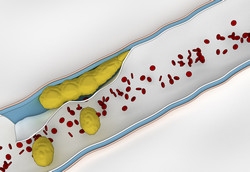Predicting atherosclerotic plaque formation
Atherosclerosis is essentially the thickening of the artery cell walls due to the deposition of white blood cells. It comprises one of the most important public health and medical issues in the Western world today as it can lead to acute myocardial infarction and death. Progression of atherosclerosis is dependent on various local haemodynamic factors, which we can now identify and measure in vivo using non-invasive cardiovascular imaging. Researchers on the EU-funded SMILE (Combination of shear stress and molecular imaging of inflammation to predict high-risk atherosclerotic plaque) project set out to test the hypothesis that low endothelial shear stress (ESS) combined with vascular inflammation could serve as markers for detecting high-risk atherosclerotic plaques. As local ESS is the ongoing stimulus for inflammation, the consortium utilised molecular magnetic resonance imaging and high-resolution computed tomography (CT) to monitor the progression of plaques in rabbit aortas. This combinatorial method enabled them to visualise accelerated plaque progression and inflammation in aortic sub-segments with low ESS. Furthermore, researchers performed a pilot clinical study for validating the predictive value of low ESS and inflammation. They used high-resolution intracoronary imaging to assess the local haemodynamic and remodelling patterns of atherosclerotic plaques. Scientists discovered a close association between low ESS and expansive remodelling with high-risk plaques. Other high-risk features such as inflammation and lipid content could further advance the screening capacity of the assay. Using these different features and markers for patient stratification would help cardiologists identify the at-risk patients. Project participants are hopeful that the implementation of this approach would improve the identification of vulnerable plaques. Early accurate identification of lesions that could progress to high-risk plaques should promptly initiate interventions such as stenting or targeted drug delivery.







